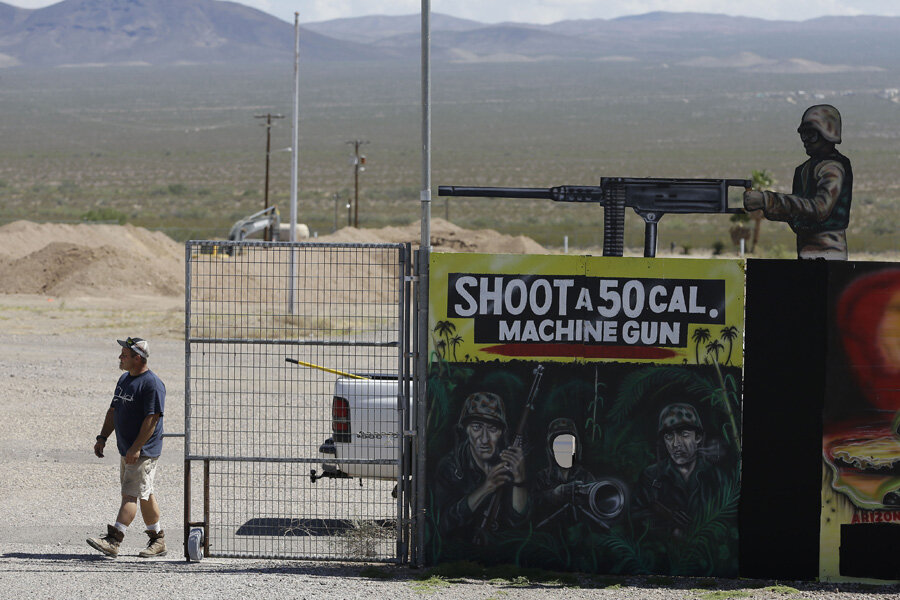Could 9-year-old's Uzi accident prompt more limits on kids?
Loading...
Handling, loading, aiming, and safely shooting small firearms remains a rite of passage for many American kids, but that exciting step toward adulthood turned into tragedy in the Mojave Desert this week when a 9-year-old girl accidentally killed a gun instructor with an Uzi submachine gun set to fully automatic.
The United States has precious few rules when it comes to children handling firearms. Indeed, culture and law tip toward early introduction to shooting, often through gun-range family picnics, Boy Scouts, or NRA training sessions that invite children to “have fun” with guns.
But even in a country in the midst of a major gun tourism boom at places like the Last Stop gun range in White Hills, Ariz., where instructor Charles Vacca was killed Monday, the shooting gave pause. It raises difficult questions not just about parental culpability, but also about whether states should ban at least heavy automatic weaponry from the hands of children.
“Arizona law allows a minor to possess a weapon if accompanied by a parent, guardian or an instructor. But this type of weapon?” writes Arizona Republic columnist E.J. Montini. “Why would a shooting range allow a kid to handle an automatic weapon? Why would a parent? And ... why would a state?”
National gun range organizations usually set 8 as the minimum age for shooting weapons at the range, as long as the children are accompanied by an adult. In Monday’s incident, the parents of the New Jersey girl, who were apparently familiar with firearms, signed a waiver allowing her to shoot the Uzi.
A video provided by the Mohave County Sheriff’s Office shows Mr. Vacca giving tips to the ponytailed girl in pink shorts, praising her for the accuracy of a practice shoot, before he tells her he has switched the weapon to fully automatic. When the girl fires again, she loses control of the bullet-pumping weapon, which arcs leftward and upward. The video clip ends before showing Vacca being shot. He died later at a hospital in Las Vegas.
The Uzi is an Israeli-made weapon popular for its small size and versatility. It can also be a dangerous weapon especially for children to handle. In 2008, an 8-year-old boy, unable to handle the recoil, shot himself in the head with an Uzi at a gun show near Springfield, Mass., during a pumpkin shooting exercise.
The main debate over kids and guns is whether training them in gun use early can prevent weapons accidents later. Social media testimony suggests that many Americans get their first exposure to guns when they’re as young as 4 or 5, under the theory that experience with guns will reduce their allure and decrease the likelihood of an accident.
There’s usually an air of excitement around such activities. At Arizona’s Scottsdale Gun Club, families can take family Christmas pics with Santa – while holding an assortment of automatic weapons. Arizona also allows 10-year-olds to hunt big game, but only if they’ve taken a certified hunting class.
The Arizona Uzi shooting has sparked heated debate on social media and in the news about the wisdom of the parents, and the responsibility on the part of the instructor, who Mohave County Attorney’s Office spokesman Jace Zack says should have probably helped the girl hold the weapon.
Some US gun ranges have already been in the process of upgrading to new sling gear that will help amateur shooters control an automatic weapon at full bore.
Research is not definitive, but critics, including Marjorie Sanfilippo, a psychologist at Eckerd College in St. Petersburg, Fla., say guns have a unique attraction to children. In research studies, kids can’t keep their hands off a gun, especially if directly told to not touch one.
At the same time, accidents on gun ranges are extremely rare. The Last Stop range – a key stop on the Bullets and Burgers, which advertises weaponry from “Rambo: First Blood Part II” – had never seen “even a scratch,” according to Last Stop owner Sam Scarmardo.
"There's nothing wrong with having children at gun ranges," Adam Winkler, a law professor at the University of California, Los Angeles, told The Wall Street Journal. "Shootings at gun ranges are freak accidents.”
On the other hand, Professor Winkler noted, 9-year-old girls firing an Uzi would be an unusual sight at most gun ranges, since "young arms might not be well equipped to handle the power of the firearm."
Americans cannot buy new automatic weapons, but can own weapons made before 1986 if they have a special tax stamp from the Bureau of Alcohol, Tobacco, Firearms and Explosives. Automatics can be used at private ranges in accordance with these regulations. These weapons are dramatically more expensive than semiautomatic rifles, with prices often reaching $25,000.
By US law, the Consumer Product Safety Commission, which regulates and puts warning notices on toys that can be dangerous, has no jurisdiction over firearms.
At the very least, the Uzi tragedy in the Mojave Desert has prompted Last Stop to review its procedures, and calls have gone out for Arizona to issue what critics say are more common-sense rules about machine guns and children.
After the 2008 Uzi shooting in Massachusetts, neighboring Connecticut passed a law barring anyone younger than 16 from shooting machine guns at gun ranges.
"This is an action states can do to prevent something like this from happening again," Lindsey Zwicker of the San Francisco-based Law Center to Prevent Gun Violence told the Associated Press after Monday’s incident.








